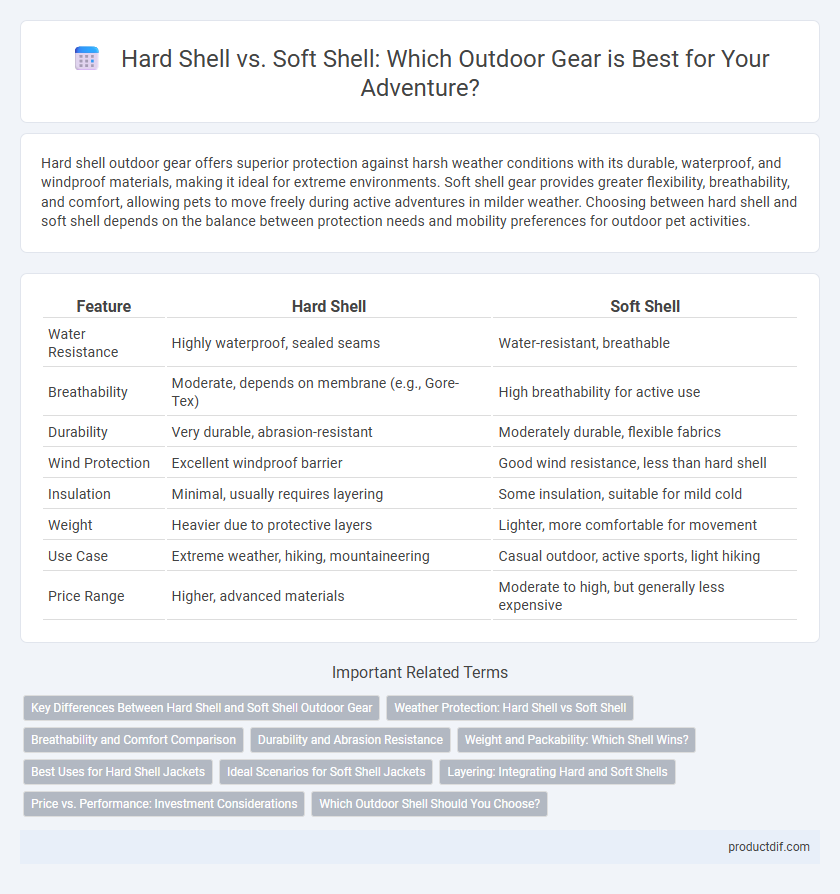Hard shell outdoor gear offers superior protection against harsh weather conditions with its durable, waterproof, and windproof materials, making it ideal for extreme environments. Soft shell gear provides greater flexibility, breathability, and comfort, allowing pets to move freely during active adventures in milder weather. Choosing between hard shell and soft shell depends on the balance between protection needs and mobility preferences for outdoor pet activities.
Table of Comparison
| Feature | Hard Shell | Soft Shell |
|---|---|---|
| Water Resistance | Highly waterproof, sealed seams | Water-resistant, breathable |
| Breathability | Moderate, depends on membrane (e.g., Gore-Tex) | High breathability for active use |
| Durability | Very durable, abrasion-resistant | Moderately durable, flexible fabrics |
| Wind Protection | Excellent windproof barrier | Good wind resistance, less than hard shell |
| Insulation | Minimal, usually requires layering | Some insulation, suitable for mild cold |
| Weight | Heavier due to protective layers | Lighter, more comfortable for movement |
| Use Case | Extreme weather, hiking, mountaineering | Casual outdoor, active sports, light hiking |
| Price Range | Higher, advanced materials | Moderate to high, but generally less expensive |
Key Differences Between Hard Shell and Soft Shell Outdoor Gear
Hard shell outdoor gear provides superior waterproofing and wind resistance through laminated membranes like Gore-Tex, making it ideal for severe weather conditions. Soft shell gear offers enhanced breathability and flexibility with stretchy woven fabrics, excelling in moderate climates and high-intensity activities. Key differences include hard shells sacrificing comfort for maximum protection, whereas soft shells prioritize thermal regulation and mobility over complete weatherproofing.
Weather Protection: Hard Shell vs Soft Shell
Hard shell jackets offer superior weather protection with their fully waterproof and windproof membranes, effectively blocking rain, snow, and harsh winds in extreme conditions. Soft shell jackets provide moderate weather resistance, designed to be water-resistant and breathable, making them ideal for milder, variable weather and high-output activities. Selecting between hard shell and soft shell depends on the level of weather exposure and the need for breathability during outdoor adventures.
Breathability and Comfort Comparison
Hard shell jackets provide superior waterproof protection with moderate breathability, making them ideal for wet conditions but less comfortable during high-intensity activities. Soft shell jackets offer enhanced breathability and flexibility, resulting in greater comfort and moisture management during dynamic outdoor pursuits in dry or mildly wet environments. Choosing between hard shell and soft shell depends on the specific balance between weather resistance and comfort needs for activities like hiking, climbing, or skiing.
Durability and Abrasion Resistance
Hard shell jackets offer superior durability and abrasion resistance, making them ideal for rugged outdoor activities where protection from sharp rocks and rough surfaces is essential. Soft shell jackets, while more flexible and breathable, generally provide less abrasion resistance and are better suited for moderate conditions with lighter wear and tear. Choosing between hard shell and soft shell depends on the intensity of use and the level of durability required for specific outdoor adventures.
Weight and Packability: Which Shell Wins?
Hard shell jackets are typically heavier and bulkier due to their durable waterproof materials, making them less packable for weight-conscious outdoor enthusiasts. Soft shell jackets offer superior packability with lighter, flexible fabrics that compress easily into smaller spaces without sacrificing breathability. For minimal weight and compact storage, soft shell gear generally wins, especially on multi-day hikes or activities requiring quick layering adjustments.
Best Uses for Hard Shell Jackets
Hard shell jackets excel in extreme weather conditions, providing superior waterproof and windproof protection due to their durable, breathable materials like Gore-Tex. They are ideal for activities such as mountaineering, alpine climbing, and heavy rain hiking where maximum weather resistance is critical. These jackets often feature reinforced seams, adjustable hoods, and ventilation zippers to balance protection with breathability during high-intensity outdoor adventures.
Ideal Scenarios for Soft Shell Jackets
Soft shell jackets excel in active outdoor pursuits where breathability and flexibility are essential, such as hiking, climbing, and trail running. Their water-resistant and windproof fabrics provide moderate protection in light rain or wind while allowing moisture to escape, keeping the wearer dry and comfortable during high-intensity activities. Ideal for cool to mild weather, soft shells offer enough insulation for layering without the bulk, making them perfect for dynamic environments requiring freedom of movement.
Layering: Integrating Hard and Soft Shells
Layering effectively with hard shells and soft shells maximizes protection and comfort in outdoor conditions. Soft shells provide breathability and flexibility as a mid-layer, while hard shells offer durable waterproofing and wind resistance as an outer layer. Combining these layers allows outdoor enthusiasts to adapt to changing weather by balancing ventilation and protection.
Price vs. Performance: Investment Considerations
Hard shell jackets generally come at a higher price point due to their superior waterproofing and durability, making them a worthwhile investment for extreme weather conditions and prolonged outdoor activities. Soft shell jackets offer enhanced breathability and flexibility at a lower cost, suitable for moderate climates and active pursuits where comfort and mobility are prioritized. Evaluating terrain, weather exposure, and activity intensity is essential to balance initial expense against long-term performance and functionality in outdoor gear selection.
Which Outdoor Shell Should You Choose?
Hard shell jackets provide superior protection against harsh weather conditions like heavy rain, snow, and strong winds due to their waterproof and windproof materials. Soft shell jackets offer enhanced breathability and flexibility, making them ideal for high-intensity activities in mild, dry conditions. Choosing between hard shell vs soft shell depends on your outdoor environment and activity level, prioritizing weather resistance or comfort and mobility.
Hard shell vs Soft shell Infographic

 productdif.com
productdif.com